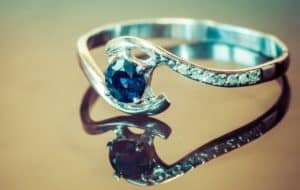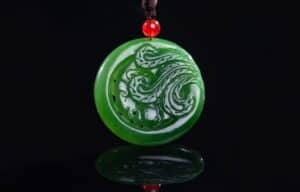Your necklace can make you outshine the rest, and statement piece play a crucial role in those first impressions. But this precious beauty comes with its bizarre talent, the ability to slide off or twist. This is undoubtedly something we don’t appreciate from our gorgeous pieces. Let’s get this twist spelled out by addressing the most common issue of preventing necklaces from getting turned.
Making the right decision while buying your chains and necklaces plays a crucial role in protecting them from twisting or sliding in future. Investing in the right kind of necklaces and being careful about the weight of the pendant can help your chain stay in place. If the clasp is too heavy for a chain, it will slide in front. If the pendant is too heavy, it will either slide around the length of your chain or turn around when subjected to sudden movements. At the same time, a big and well balanced bail can keep your pendant in place. Additionally, heavy and structurally stable chains and necklaces are more likely to stay in place when compared to thinner ones. However, the game is not over if you have bought a necklace that does not suit the mentioned parameters. There are things that you can do to still make it work, e.g., add charms, balancers or stabilizers.
Before we get into details about these alternatives, let’s grace our way to understand about counterweight and another great tool, necklace stabilizer. As the latter’s name goes by, it helps to keep the necklace from turning around. This way, whenever I mention these in the following sections, you will have a better understanding of what I am referring to
Necklace counterweight
Counterweight or counterbalance gives a jewelry piece more balance to stay at a place. It can be anything ranging from a charm, a higher weighted piece of metal, to just some layers of the same material soldered around or at the base of the clasp. A light chain with a heavy pendant is an imbalanced deal. In this case, the counterweight, added to the clasp, helps to balance out this combination by acting as an offset. A rear counterweight near the clasp negates the weight of the pendant, thus balancing everything.
Necklace stabilizers
An improvised jewelry piece that prevents the necklace from reorienting itself around the neck of the wearer. Its design is such that weight is attached at the backside of the neck, extending downwards.
- It prevents the clasp from gracing the neck on the front, the very thing a jewelry lover does not want.
- It is mounted on an extender, the latter, which helps keep the clasp on the backside, thus the pendant on the front.
- It can come as an oval-shaped metal loop connected by clasps to the rear ends of the neckpiece, resting on the backside of the neck. It prevents the necklace from getting twisted while it remains in the proper position.
What does it mean when the necklace turns around?
If the necklace keeps turning around, it means that the chain of the necklace (if lightweight) keeps moving around your neck. It happens when:
- while wearing the necklace, you do not straighten it up before securing the clasp. You need to ensure that there are no bends in the necklace when you are wearing it. If the chain has a single curve, it has a high probability of turning around.
- the clasp is heavier than the chain. Due to gravity, the heavier part tends to move to the lowest part of the chain or necklace. Usually, its clasp or lock rides fall on the side of the front neck, which ultimately turns to the chest, clearly much to our dismay.
- we use it as a fidget. Playing with your necklace makes it moves it from it’s resting place. This makes it turn around at different places.
- the pendant is too heavy for the chain. If the pendant moves around too much, it sometimes makes the necklace turn around.
How do I keep the necklace from turning around?
It is a common issue faced by jewelry lovers. No matter which brand or design they go for, turning around the necklace is always the major mood spoiler. To tackle this issue, we may try the following:
- Choose the right balanced necklace piece. Ensure the pendant’s weight and chain parameters balance each other well. Any disbalance in this ratio results in the necklace’s issue of turning around repeatedly
- Go for a necklace stabilizer. It will help the clasp to stay on the back side by providing additional weight.
- Add a counterweight near the clasp. It will make the necklace more balanced weight, thus preventing it from turning around.
- Invest in necklaces where the center is the heaviest part. If it has multiple stones, the necklaces that have biggest stone in the center balance well in comparison to the ones that have the same stones across.
- Stop fidgeting with the necklace. This allows it to stay in place.
- You may also visit your jeweler and ask them to attach a charm on the chain. They would know how to balance the chain with a charm.

How do you stop your necklace clasps from turning around?
Certainly for almost all, turning around of the necklace translates to the clasp following its way to the front. To end this struggle for all, here are tips to your rescue.
- Balanced pendant-chain ratio
As discussed previously, the chain should be in proportion to the pendant to carry the pendant’s weight. A thin and short-chain paired with a big heavy pendant is the worst combination, no matter how alluring it may seem to the eyes.
- Use bails to hide the clasp
The clasps are a bother only when it’s visible. You can hide them by using heavy bails attached to them, large enough to hide the clasp.
- Add counterweight near or to the clasp
Also discussed in the previous section, the counterweight distributes the weight of the pendant. The counterweight can be any decoration piece or charm and varies with the jewelry design. However, the charm must be heavier than the pendant.
- Eyelash glue
Yes! applying some eyelash glue at the back of your neck and then sticking the clasp to it can work. It is mostly helpful when your necklace is no too heavy.
- A model tape, band-aid or duct tape to the rescue
Another trick will be to stick the necklace using duct tape or plaster tape on the back of the neck. It is a successful one-time hack for that special occasion, especially at the last moment, but a big no on summers. However, as the tape you use may not stay in place, and also, may look bad when seen at the back, do this only for parties or other similar occasions. Having your hair open also helps in hiding the tape at the back. Also, be mindful of the tape as it may come in front and be visible to everyone if it comes undone. Model tapes are normally not very noticeable.
- Buy a cool clasp
Ordinary clasps appear bothersome, but what if they are cool or appealing? Toggle clasps come to the rescue. Even when hanging on the front with the pendant, they look cool. They come with chains like the Omega chain.
- Go for chains with in-built clasps
Some chains in the market are popular for their blended-in clasps. The clasps are designed in such a way that they blend well with the chain.
- Opt for the metal chain with an extender
The extender can be an add-on to your necklace to bring more weightage on the back. This extra weight is sufficient to hold the clasp on the back.
- Give yourself a multi-clasp necklace
- Get several short but identical chains, each with a decorative clasp.
- Add as many links to get to the desired length.
- With so many clasps in just a single necklace, there’s no way the moving around of the necklace is an issue. A big game-changer indeed in the field of necklaces without pendants.
- Go clasp-less
There are many necklaces in the market without clasps. You can easily buy one or get yours clasp-less by getting its clasp segment disintegrated.
- Be careful when you wear it
Hold both the ends of the chain in each hand, ensure you see no turns and twists in the necklace, and then put it on.

How do I keep my pendant from turning around?
Following are certain tips and tricks that you may try out to keep your pendant from rotating.
- Chose a thick chain
Go for a chain that is thick and slightly heavy. A pendant is more likely to turn in a thin chain and heavier chains keep it balanced and in place. Thicker and heavier chains have a structure to them and stay in place, keeping the pendant in place at most times.
- Go for shorter lengths
If the chain is short, the pendant is less likely to turn. Any pendant in a chain under 16 inches will most likely stay in place. At the same time, a pendant in a 24 inch or 32 inch necklace will have a higher probability of being in place. This is because longer chains give a lot of room to the pendants to turn around.
- Large bail
Large bails normally keep the pendant in place. Your bail may slide a little as you move, however, the pendant does not turn around.
- Add a counterweight to your neckpiece
- This simple yet effective method works provided the counterweight i.e, any decoration piece is heavier than the pendant. It offsets the weight of the pendant, thus creating a balance.
- Balanced chain-pendant ratio to keep the pendant adorning your neck on the front.
- Choose the necklace with the pendant attached.
Choose the neckpiece with the pendant attached to its rear ends or, go for getting your pendant soldered to the chain. It will prevent the pendant from turning around.
- Length should be in line with your dress’s neckline
The length of your necklace should allow the pendant to rest either above the neckline, or a few inches below the neckline. This way, the pendant will be more stable. If it falls on the neckline, your pendant will move with every movement in your dress’s neckline. This increases the probability of the pendant turning.
- Tie a knot for nylon or satin threads
If you are wearing your pendant in a nylon or satin thread, or something similar, this can work great. Depending upon the shape and type of your pendant, you can either tie 1 or 2 knots at the back of the pendant, or 1 knot at each side to keep it in place. These knots are normally not very noticeable and do not allow the pendant to move freely around the length of the necklace. This may also work for jewelry wires in some cases.

How do you keep metal chains from twisting?
If you are someone, who loves to wear more than one necklace at a time, commonly called layering, the most common problem you face is the tangling or twisting of the metal chains. The fine metal chains used in necklaces are quite fragile and thus tend to get entangled very often.
Here are a few lifesaving tips for wearing layering necklaces like a pro without the risk of getting them tangled.
- Opt for necklaces of different lengths
Lengths can play one of the roles in getting two metal chains tangled. Neckpieces of similar lengths come in contact with each other more often than those of different lengths.
- Opt for chains with different weights
Similar to the lengths, weight can also make your tangling and twisting problem worse. Pair a heavier chain like a rope chain with a lighter chain to create a balance.
- Use a necklace spacer
Available with two to three clasps, necklace spacers link the necklaces at the back of your neck, with an appropriate space between them, thus preventing them from entangling.
- Link your neckpieces together
Linking the necklaces together is as easy as it sounds. Put the necklaces on and turn them around such that their clasps are at the front. Link the clasp of one necklace to another. This method is perfect for preventing tangles as well as providing ease in adjusting the lengths of the necklaces.
If you want to read more about knots getting developed when layering, check out our detailed article here.
How to store necklaces to prevent them from getting twisted and entangled?
Packing or storing necklaces when not in use is equally essential, as the last thing you want is to see your necklace twisted at the last moment. Here are a few essential tips.
- Drinking straw at rescue: Thread the necklace through a drinking straw and close the clasp. It will prevent the necklace from getting twisted and remaining knot-free.
- Lined zipped bags: Another simplest way is to store all necklaces twist and tangle-free is by placing them in separate zipped bags with their clasp hanging out. It prevents the clasp from gracing the neck on the front, the very thing a jewelry lover does not want. It acts as a weight attached to the backside of the necklace, such that the additional weight prevents the clasp from making its way to the front.
- Kitchen towel rolls or toilet paper rolls: You can use any round thing. Even good quality plastic bottles can be used for the job after being sterilized. Spare pencils also work well for thicker chains. In fact, these are better than paper or carboard rolls as paper or cardboard may absorb moisture present in the air which can harm your jewelry. Noe take one end of your necklace and tape it to one of the roll. Now very gently roll the entire necklace so that the other end of the necklace comfortably reaches the other end of your roll. For shorter chains, you may re-clasp the chain around the roll. This way, multiple chains may be added to a single roll. Tape this end here. Now your necklace won’t move in storage and hence, won’t get tangled. You may further store the roll in an air-tight zip-lock bag to prevent moisture and other harmful gases present in the air from damaging your necklace.
- Use some other object: Not just rolls, you can even wrap the necklaces around neatly folded clothes. Soft cloths work really well for wrapping necklaces. If you have small pillows from your watches or old bracelets, they may also be used to wrap the necklace around.
- Cling wrap: Yes! You can simply lay your necklace or chain straight on a cling wrap. You may then carefully roll it in and place it in your jewelry box.
- Wall mounted jewelry hanger: Wall mounted necklace hangers have multiple pegs. you need to install one that has good amount of space between each peg. These can be mounted on a wall or inside your wardrobe door. You may hang your daily wear necklaces on these. However, do not hang necklaces for long term storage on it as it exposes them to air and moisture.
- Use jewelry rolls or organizers: You can safely store your necklaces in jewelry rolls. Custom organizers for necklaces are easily available and a lot of local jewelers also use them. If you wish to store other jewelry items as well, you can buy regular jewelry rolls as well. You just need to place your jewelry in them and they roll like a purse or a pouch.
Conclusion
Neckpieces are highly adorned jewelry by many. Wearing your favorite dress and pairing it with your most loved necklace is a sure-shot winner. Making the right purchase, or gaining a little understanding about the size, thickness and weights of your necklaces and pendants, you can wear them like you own them. They will listen to you and stay in place, making you feel more confident of your look.
Good luck! 🙂




